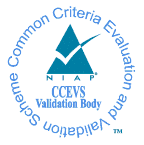Related Research Articles
Trusted Operating System (TOS) generally refers to an operating system that provides sufficient support for multilevel security and evidence of correctness to meet a particular set of government requirements.
In computing, security-evaluated operating systems have achieved certification from an external security-auditing organization, the most popular evaluations are Common Criteria (CC) and FIPS 140-2.
The Federal Information Processing Standard Publication 140-2,, is a U.S. government computer security standard used to approve cryptographic modules. The title is Security Requirements for Cryptographic Modules. Initial publication was on May 25, 2001, and was last updated December 3, 2002.
Multilevel security or multiple levels of security (MLS) is the application of a computer system to process information with incompatible classifications, permit access by users with different security clearances and needs-to-know, and prevent users from obtaining access to information for which they lack authorization. There are two contexts for the use of multilevel security.
The Evaluation Assurance Level of an IT product or system is a numerical grade assigned following the completion of a Common Criteria security evaluation, an international standard in effect since 1999. The increasing assurance levels reflect added assurance requirements that must be met to achieve Common Criteria certification. The intent of the higher levels is to provide higher confidence that the system's principal security features are reliably implemented. The EAL level does not measure the security of the system itself, it simply states at what level the system was tested.

The Kitemark is a UK product and service quality trade mark which is owned and operated by the British Standards Institution.
Information security standards or cyber security standards are techniques generally outlined in published materials that attempt to protect the cyber environment of a user or organization. This environment includes users themselves, networks, devices, all software, processes, information in storage or transit, applications, services, and systems that can be connected directly or indirectly to networks.

Certification is part of testing, inspection and certification and the provision by an independent body of written assurance that the product, service or system in question meets specific requirements. It is the formal attestation or confirmation of certain characteristics of an object, person, or organization. This confirmation is often, but not always, provided by some form of external review, education, assessment, or audit. Accreditation is a specific organization's process of certification. According to the U.S. National Council on Measurement in Education, a certification test is a credentialing test used to determine whether individuals are knowledgeable enough in a given occupational area to be labeled "competent to practice" in that area.

Product certification or product qualification is the process of certifying that a certain product has passed performance tests and quality assurance tests, and meets qualification criteria stipulated in contracts, regulations, or specifications.

The Federal Office for Information Security is the German upper-level federal agency in charge of managing computer and communication security for the German government. Its areas of expertise and responsibility include the security of computer applications, critical infrastructure protection, Internet security, cryptography, counter eavesdropping, certification of security products and the accreditation of security test laboratories. It is located in Bonn and as of 2024 has about 1,700 employees. Its current president, since 1 July 2023, is former business executive Claudia Plattner, who took over the presidency from Arne Schönbohm.
A Protection Profile (PP) is a document used as part of the certification process according to ISO/IEC 15408 and the Common Criteria (CC). As the generic form of a Security Target (ST), it is typically created by a user or user community and provides an implementation independent specification of information assurance security requirements. A PP is a combination of threats, security objectives, assumptions, security functional requirements (SFRs), security assurance requirements (SARs) and rationales.

Common Criteria Evaluation and Validation Scheme (CCEVS) is a United States Government program administered by the National Information Assurance Partnership (NIAP) to evaluate security functionality of an information technology with conformance to the Common Criteria international standard. The new standard uses Protection Profiles and the Common Criteria Standards to certify the product. This change happened in 2009. Their stated goal in making the change was to ensure achievable, repeatable and testable evaluations.
The Common Criteria model provides for the separation of the roles of evaluator and certifier. Product certificates are awarded by national schemes on the basis of evaluations carried by independent testing laboratories.
Cryptographic Module Testing Laboratory (CMTL) is an information technology (IT) computer security testing laboratory that is accredited to conduct cryptographic module evaluations for conformance to the FIPS 140-2 U.S. Government standard.
The CESG Claims Tested Mark, formerly CSIA Claims Tested Mark, is a UK Government Standard for computer security.
Common Criteria for Information Technology Security Evaluation, version 3.1 Part 1 defines the Security Target (ST) as an "implementation-dependent statement of security needs for a specific identified Target of Evaluation (TOE)". In other words, the ST defines boundary and specifies the details of the TOE. In a product evaluation process according to the CC the ST document is provided by the vendor of the product.
Digital supply chain security refers to efforts to enhance cyber security within the supply chain. It is a subset of supply chain security and is focused on the management of cyber security requirements for information technology systems, software and networks, which are driven by threats such as cyber-terrorism, malware, data theft and the advanced persistent threat (APT). Typical supply chain cyber security activities for minimizing risks include buying only from trusted vendors, disconnecting critical machines from outside networks, and educating users on the threats and protective measures they can take.
IEC 62443 is an international series of standards that address cybersecurity for operational technology in automation and control systems. The standard is divided into different sections and describes both technical and process-related aspects of automation and control systems cybersecurity.

Platform Security Architecture (PSA) Certified is a security certification scheme for Internet of Things (IoT) hardware, software and devices. It was created by Arm Holdings, Brightsight, CAICT, Prove & Run, Riscure, TrustCB and UL as part of a global partnership.

Standardisation Testing and Quality Certification (STQC) Directorate, established in 1980, is an authoritative body offering quality assurance services to IT and Electronics domains.
References
- ↑ "Publications: CC Portal" . Retrieved 2024-01-06.
- ↑ "Common Criteria - Communication Security Establishment". Archived from the original on 2021-02-01. Retrieved 2015-03-02.
- ↑ "Common Criteria Certified Products" . Retrieved 2023-12-30.
- ↑ "Indian Common Criteria Certification Scheme (IC3S) Overview" . Retrieved 2023-12-30.
- ↑ "Arrangement on the Recognition of Common Criteria Certificates in the field of Information Technology Security" (PDF). 2014-07-02. Retrieved 2023-12-30.
- ↑ "Common Criteria Management Committee Vision Statement" (PDF). 2012-09-01. Retrieved 2023-12-30.
- ↑ Under Attack: Common Criteria has loads of critics, but is it getting a bum rap Archived 2021-04-23 at the Wayback Machine Government Computer News, retrieved 2007-12-14
- ↑ Wheeler, David (2006-12-11). "Free-Libre / Open Source Software (FLOSS) and Software Assurance / Software Security" (PDF). Retrieved 2023-12-30.
- ↑ Wäyrynen, J.; Bodén, M.; Boström, G. "Security Engineering and eXtreme Programming: An Impossible Marriage?". Lecture Notes in Computer Science. doi:10.1007/978-3-540-27777-4_12.
- ↑ Beznosov, Konstantin; Kruchten, Philippe (2005-10-16). "Towards Agile Security Assurance" . Retrieved 2023-12-30.
- ↑ Kallberg, Jan (2012-08-01). "Common Criteria meets Realpolitik - Trust, Alliances, and Potential Betrayal" (PDF). Retrieved 2023-12-30.
- ↑ Parsovs, Arnis (2021-03-03). Estonian Electronic Identity Card and its Security Challenges (PhD) (in Estonian). University of Tartu. pp. 141–143. Retrieved 2023-12-30.
- ↑ "CAPS: CESG Assisted Products Scheme". Archived from the original on 2008-08-01.
- ↑ Infosec Assurance and Certification Services (IACS) Archived February 20, 2008, at the Wayback Machine
- ↑ Salter, Chris (2011-01-10). "Common Criteria Reforms: Better Security Products Through Increased Cooperation with Industry" (PDF). Archived from the original (PDF) on April 17, 2012.
- ↑ Brickman, Joshua (2011-03-11). "Common Criteria "Reforms"—Sink or Swim-- How should Industry Handle the Revolution Brewing with Common Criteria?". Archived from the original on 2012-05-29.
- ↑ "CCRA Management Committee Vision statement for the future direction of the application of the CC and the CCRA" (DOCX). 2012-09-18. Retrieved 2023-12-30.